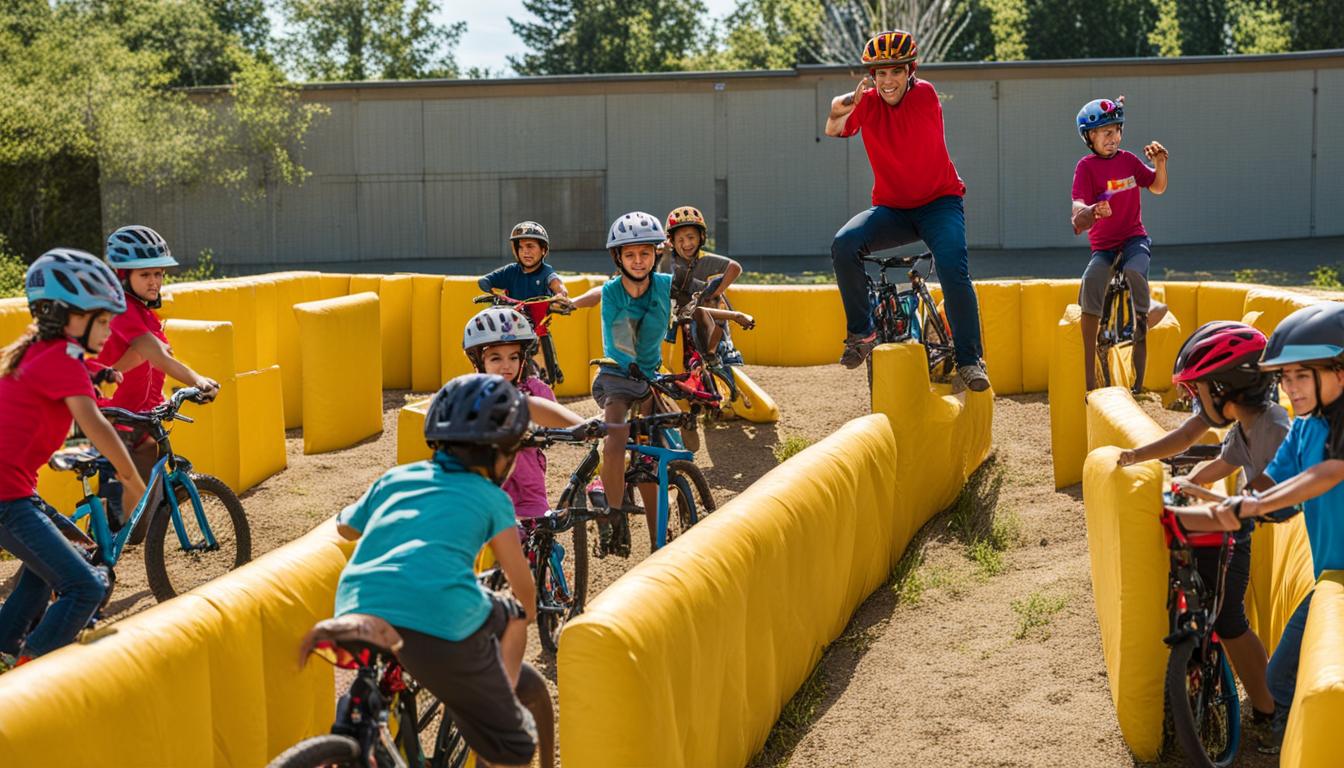Do you remember the first time you hopped on a bike as a child? The thrill of the open road, the wind in your hair, the sense of freedom and adventure. Cycling is not only a fantastic recreational activity but also an essential skill for children to learn. But here’s a question for you: what if I told you that teaching kids bike-handling skills and techniques goes beyond just riding a bike?
It’s true! Mastering bike-handling skills at a young age can have a profound impact on your child’s overall cycling experience. From boosting their confidence, and enhancing safety awareness, to improving their control and coordination, these skills lay the foundation for a lifelong love of cycling.
So, where do we begin? In this comprehensive guide, we will dive into the various aspects of teaching kids bike-handling skills and techniques. From getting started with kids’ bike lessons to riding basics, building confidence through beginner bike riding classes, and ensuring youth bike safety training, we’ve got it covered. And that’s not all – you’ll also discover a range of fun and engaging bike riding drills tailor-made for kids.
Get ready to embark on a journey that will not only teach your child vital bike-handling skills but also create unforgettable moments and a lifetime of joy on two wheels.
Key Takeaways:
- Teaching kids bike-handling skills and techniques can have a significant impact on their overall cycling experience.
- Mastering bike-handling skills at a young age enhances confidence, safety awareness, control, and coordination.
- Getting started with kids’ bike lessons, focusing on riding basics, and enrolling in beginner bike riding classes can accelerate skill development.
- Youth bike safety training is crucial for ensuring a safe cycling environment.
- Bike riding drills tailored for kids offer a fun and engaging way to improve bike-handling skills.
Getting Started: Kids Bike Lessons
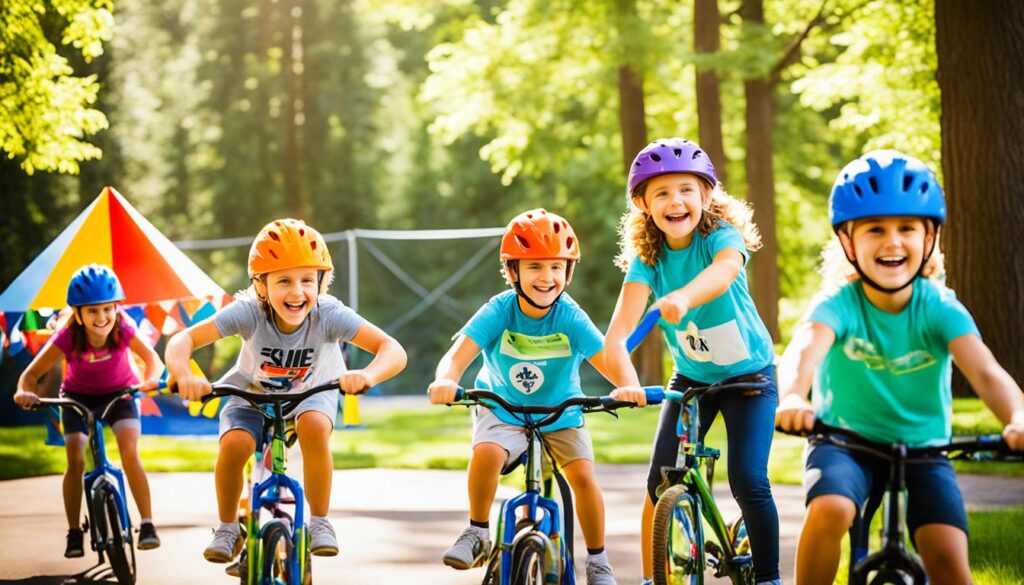
Before your little one becomes the next cycling superstar, it’s crucial to lay the groundwork with fun and engaging kids’ bike lessons. These initial steps will help them develop the necessary skills and confidence to embark on their two-wheeled adventures. Whether you’re a parent, guardian, or instructor, here are some valuable tips to kickstart your cycling journey:
Introducing Children to Bike Riding
Introducing children to bike riding should be approached with excitement and encouragement. Start by creating a positive association with bikes, demonstrating your enthusiasm for this thrilling outdoor activity. You can use colorful pictures, stories, or even a visit to a local bike shop to get them excited about their very own set of wheels. Remember, a little enthusiasm goes a long way.
Selecting the Right Size Bike
Proper bike fit is crucial when it comes to comfort, control, and safety. Ensure you select the right size bike for your child’s age and height. They should be able to touch the ground with their feet while sitting on the saddle, allowing them to balance themselves confidently. Take them along to try out different sizes and models, encouraging them to find the one that feels comfortable and secure.
Creating a Safe Learning Environment
Creating a safe learning environment is essential during kids’ bike lessons. Find a spacious and open area, such as a park or a quiet street, away from traffic and obstacles. Remove any potential hazards and ensure that the environment is conducive to learning and exploration. Don’t forget to equip your young cyclist with a well-fitted helmet to prioritize their safety.
“Learning to ride a bike is a rite of passage, filled with joy, laughter, and a sense of independence. By providing kids bike lessons, you’re setting them up for a lifetime of adventure and healthy habits.”
Remember, everyone learns at their own pace, so be patient and encouraging throughout the kid’s bike lessons. Reinforce the importance of balance and show them how to properly use the brakes. With practice, perseverance, and a little bit of guidance, your child will soon be pedaling like a pro!
Riding Basics: Children’s Cycling Tips
Once your child has mastered the art of bike riding, it’s time to delve into the essential techniques that will take their cycling skills to the next level. The inquisitive nature of children makes it the perfect time to introduce them to balancing, steering, braking, and pedaling techniques.
Focus on Balance
The key to riding with confidence lies in mastering balance. Start by instructing your child to maintain a straight line while coasting on their bike. Encourage them to practice by lifting their feet off the ground and coasting down gentle slopes – always under your watchful eye, of course. This will help them develop a strong sense of balance and stability, making their riding experience smoother and more enjoyable.
Steer with precision
Teaching children how to steer their bikes effectively is an essential skill that will give them control over their movements. Encourage your child to practice turning by setting up a simple obstacle course in an open area. This will allow them to navigate around objects, teaching them how to steer smoothly and make precise adjustments while riding.
Mastering Braking Techniques
Teaching your child to brake properly is crucial for their safety and overall riding experience. Teach them to use both the front and rear brakes simultaneously, as this provides optimal control and stopping power. Start with gentle braking exercises, gradually increasing their speed and complexity as their confidence and abilities grow.
Powerful Pedaling
Help your child develop efficient pedaling techniques by teaching them to maintain a steady rhythm and apply consistent pressure on the pedals. Encourage them to use both legs evenly for a balanced and efficient pedaling motion. It’s also important to emphasize the importance of gear shifting to adapt to different terrain and riding conditions.
“Teaching children the basics of balancing, steering, braking, and pedaling is like equipping them with superpowers that will propel their cycling adventures to new heights.”
| Children Cycling Tips | Teaching Children to Ride a Bike |
|---|---|
| Focus on balance | Start by instructing your child to maintain a straight line while coasting on their bike. Encourage them to practice by lifting their feet off the ground and coasting down gentle slopes. |
| Steer with precision | Teach your child to navigate around objects by setting up a simple obstacle course. This will help them develop smooth steering skills and make precise adjustments while riding. |
| Master braking techniques | Teach your child to use both front and rear brakes simultaneously for optimal control and stopping power. Start with gentle braking exercises and gradually increase speed and complexity. |
| Powerful pedaling | Teach your child to maintain a steady pedaling rhythm and apply consistent pressure on the pedals using both legs evenly. Emphasize the importance of gear shifting for different riding conditions. |
Building Confidence: Beginner Bike Riding Classes
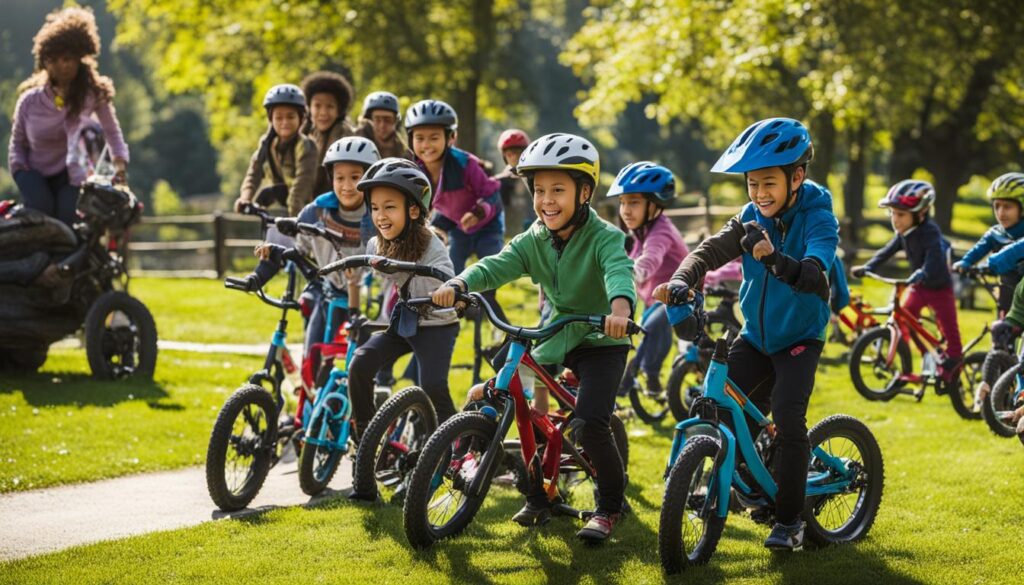
To boost your child’s confidence and foster their love for cycling, enrolling them in beginner bike riding classes can be highly beneficial. These structured programs are specifically designed to provide young cyclists with the guidance, support, and skills they need to become confident riders.
One of the major advantages of beginner bike riding classes is the professional coaching your child will receive. Certified instructors are trained to work with young riders and understand their unique needs. They have the expertise to teach essential bike-handling techniques and help children overcome any fears or challenges they may face.
Through a combination of group activities, individual practice, and fun games, these classes create a supportive and encouraging environment for your child to learn and grow. They’ll have the opportunity to interact with fellow young cyclists, fostering a sense of camaraderie and motivation.
Moreover, beginner bike riding classes focus on progressive skill development. The curriculum is carefully structured to introduce new concepts and techniques gradually, building upon the foundation established in previous lessons. This ensures that your child continues to develop their cycling abilities in a safe and controlled manner.
| Benefits of Beginner Bike Riding Classes |
|---|
| 1. Professional coaching and guidance |
| 2. Supportive and encouraging environment |
| 3. Progressive skill development |
| 4. Building camaraderie with fellow young cyclists |
When selecting a beginner bike riding class for your child, it’s essential to consider a few factors. Look for a reputable program that aligns with your child’s age and skill level. Check if the instructors are certified and experienced in working with young riders. Additionally, inquire about the class size, duration, and location to ensure it suits your child’s schedule.
By enrolling your child in beginner bike riding classes, you’re not only providing them with expert coaching but also instilling a lifelong passion for cycling. These classes lay the foundation for your child’s cycling journey, equipping them with the skills, confidence, and joy that come with riding a bike.
Testimonial:
“I enrolled my daughter, Emma, in a beginner bike riding class, and it was one of the best decisions I made. The instructors were patient, encouraging, and taught her valuable bike-handling skills. Emma’s confidence soared, and she now enjoys riding her bike every chance she gets!” – Sarah, proud parent
Upcoming Beginner Bike Riding Classes in Your Area:
- Ace Cycling School – Ages 5-8
- Quick Wheels Bike Academy – Ages 6-10
- Pedal Power Kids – Ages 4-7
- Ride with Confidence – Ages 7-11
Don’t miss out on the opportunity to enroll your child in a beginner bike riding class. Witness their transformation from a hesitant rider to a confident cyclist as they embark on this exciting journey of learning, growth, and fun!
Safety First: Youth Bike Safety Training
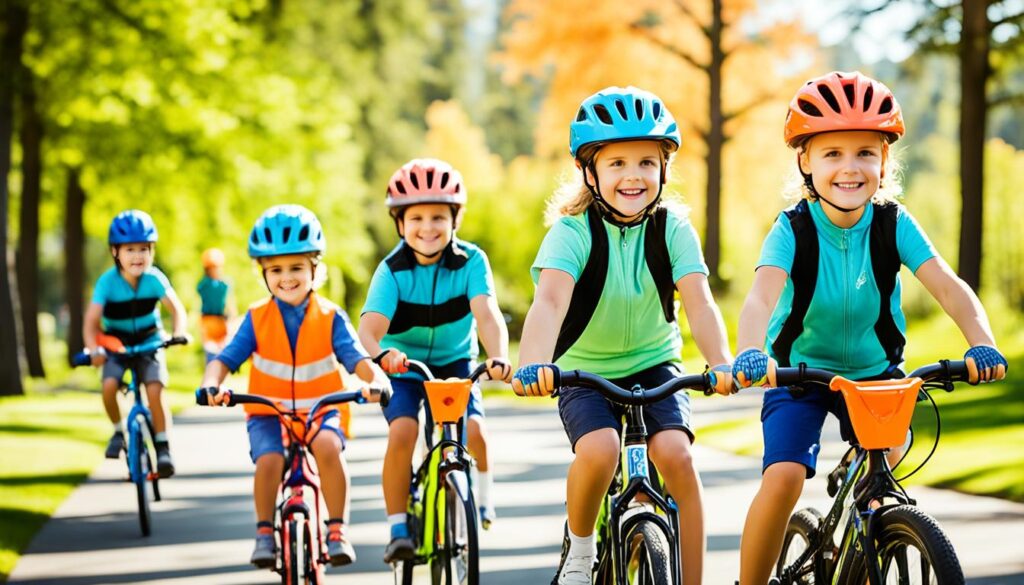
Safety is paramount when it comes to cycling. As parents and guardians, it’s our responsibility to ensure that our kids have the necessary skills and knowledge to stay safe on their bikes. Youth bike safety training plays a crucial role in equipping young cyclists with the tools they need to navigate the roads confidently, responsibly, and securely.
One of the essential aspects of youth bike safety training is teaching children the importance of wearing helmets. Helmets act as a vital protective barrier, reducing the risk of head injuries and concussions in case of accidents or falls. Teach your child the proper way to wear a helmet, making sure it fits snugly, covering their forehead and not tilting backward or forward.
Another key component of youth bike safety training is teaching children how to perform routine bike maintenance checks. Regularly inspect their bikes for any loose bolts, damaged brakes, or worn-out tires. Teaching your child how to clean and lubricate their bike’s chain, as well as inflate the tires, will not only keep their bike in good working condition but also instill a sense of responsibility and self-reliance.
Road awareness is another crucial aspect of youth bike safety training. Teach your child to always be aware of their surroundings, follow traffic rules and signals, and understand basic road signs. Instill in them the importance of using hand signals to indicate their intentions, such as stopping or turning, before making any maneuvers on the road.
Through youth bike safety training, we can empower our young cyclists to confidently navigate the roads, ensuring their safety and the safety of those around them. By emphasizing the importance of helmet usage, bike maintenance checks, and road awareness, we can equip them with the knowledge and skills they need to enjoy cycling while minimizing risks.
Mastering Techniques: Bike Riding Drills for Kids
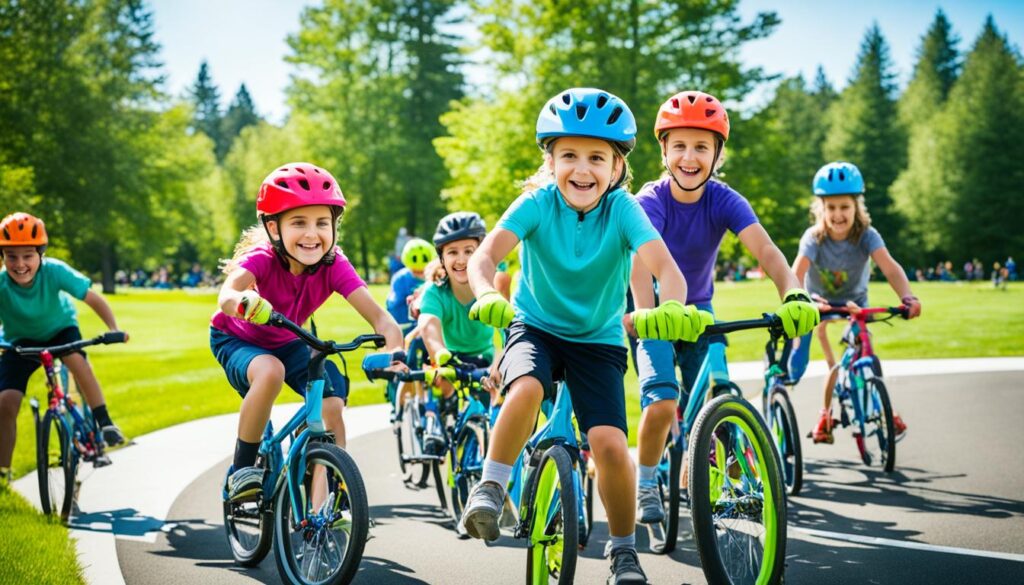
When it comes to teaching your little one how to ride a bike, incorporating bike riding drills can make the learning process both fun and effective. These drills are designed to improve your child’s bike-handling skills, focusing on essential aspects such as balance, control, and coordination.
One exciting bike riding drill is the “Tightrope Walk.” Set up a narrow path using cones or other markers and challenge your child to ride along the path while maintaining balance and control. This drill not only enhances their balance skills but also improves their ability to steer accurately.
Another fantastic drill is the “Slalom Challenge.” Create a series of cones or objects arranged in a zigzag pattern and ask your child to navigate through them. This drill helps improve their maneuvering skills and teaches them how to adjust their speed and direction while riding.
For honing their braking techniques, try the “Quick Stop” drill. In a safe, open area, instruct your child to ride at a moderate speed and on command, practice stopping quickly by squeezing the brakes. This drill helps them develop the reflexes needed to respond swiftly to potential hazards on the road.
A favorite among young cyclists is the “Figure 8 Challenge.” Set up two circles or any other shape that resembles the number 8, and have your child ride within and around the shape continuously. This drill enhances their coordination and control while making their riding experience more enjoyable.
Additionally, incorporating games into bike riding drills can enhance engagement and motivation. Consider organizing a friendly bike race or creating an obstacle course where your child can practice various skills simultaneously.
Remember, safety should always be a top priority when practicing bike riding drills. Ensure your child wears a properly fitted helmet and protective gear, and always supervise their practice sessions.
By incorporating these bike riding drills into your child’s training routine, you can help them master essential bike-handling techniques while keeping the learning process fun and exciting. So go ahead and hit the pavement with your young cyclist, and watch them grow into confident riders!
| Bike Riding Drills for Kids | Skills Developed |
|---|---|
| Tightrope Walk | Balance, control, and steering accuracy |
| Slalom Challenge | Maneuvering skills and speed adjustment |
| Quick Stop | Braking techniques and quick reflexes |
| Figure 8 Challenge | Coordination and control |
Kid-Friendly Biking Instruction
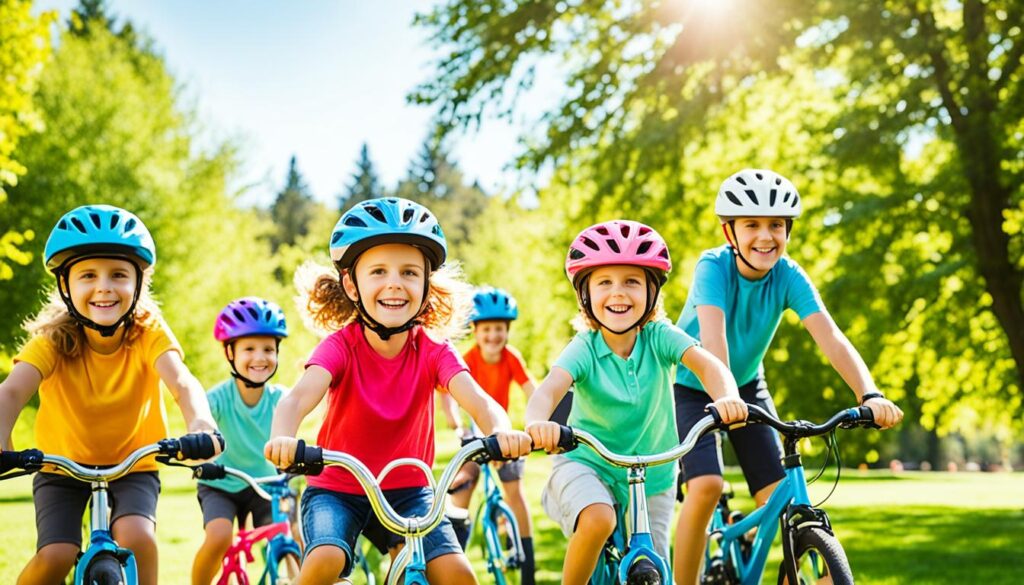
When it comes to teaching your child how to ride a bike, the key is to make it a fun and engaging experience. Kid-friendly biking instruction methods not only ensure that your little one learns the necessary skills but also keep them excited about riding. By incorporating strategies that cater to their age and interests, you can create a positive learning environment and set them up for success.
One approach to kid-friendly biking instruction is to turn it into a game. Children love challenges, so why not make learning new biking techniques a playful competition? Set up obstacle courses or create a treasure hunt where they have to navigate through different terrain to find hidden treasures. This not only helps improve their bike-handling skills but also adds an element of excitement and adventure.
Another way to make bike lessons enjoyable is to involve their favorite characters or superheroes. Incorporate themed gear like helmets and jerseys featuring their beloved characters. You can also encourage them to come up with imaginative stories or scenarios while riding, tapping into their creativity and making the experience more engaging for them.
“Kid-friendly biking instruction methods not only ensure that your little one learns the necessary skills but also keeps them excited about riding.”
Customizing the learning experience
Every child is unique, and their learning preferences may vary. It’s essential to customize the biking instruction to suit their individual needs. Some children may be more visual learners, so using visual aids like diagrams, videos, or even drawing bike paths on the ground can help them grasp the techniques better.
For those who thrive on social interaction, organizing group bike riding sessions can be a great idea. Not only does this allow them to learn from their peers, but it also adds a social aspect to the experience, making it more enjoyable and motivating.
Remember to keep the instructions simple and easy to understand. Break down complex techniques into smaller, manageable steps, and praise their efforts and progress along the way. Positive reinforcement goes a long way in boosting their confidence and encouraging them to continue learning.
Wrapping up the Lesson: Kid-Friendly Instruction Recap
When it comes to teaching kids how to ride a bike, embracing kid-friendly biking instruction methods is key. By incorporating games, themes, and customized learning experiences, you can make bike lessons fun and engaging, creating a positive learning environment for your child. Remember to focus on their individual needs and always celebrate their achievements. With the right approach, your child will master biking skills and techniques while enjoying every moment of the journey.
| Technique | Description |
|---|---|
| Turn it into a game | Create fun challenges and obstacle courses |
| Incorporate favorite characters | Use themed gear and encourage imaginative play |
| Customize the learning experience | Adapt instruction methods to suit individual needs |
| Organize group riding sessions | Facilitate social interaction and peer learning |
| Keep instructions simple and positive | Break down techniques and provide positive reinforcement |
Conclusion
Teaching kids bike-handling skills and techniques is an essential part of their cycling journey. By equipping your child with the necessary knowledge and abilities, you can empower them to become confident and safe cyclists.
Through children’s cycling tips and beginner bike riding classes, you can lay a strong foundation for their biking adventures. Coaching young cyclists with kid-friendly biking instruction methods ensures a positive learning experience that keeps them engaged and motivated.
Don’t forget about youth bike safety training, which instills crucial habits such as wearing helmets, performing bike maintenance checks, and practicing road awareness. By incorporating bike riding drills for kids into their training, you’ll help them develop balance, control, and coordination.
In summary, by teaching kids bike-handling skills and techniques, you provide them with the tools they need to fully enjoy the cycling experience. So, get out there and guide your young riders on their journey to becoming skillful, confident, and safe cyclists!
